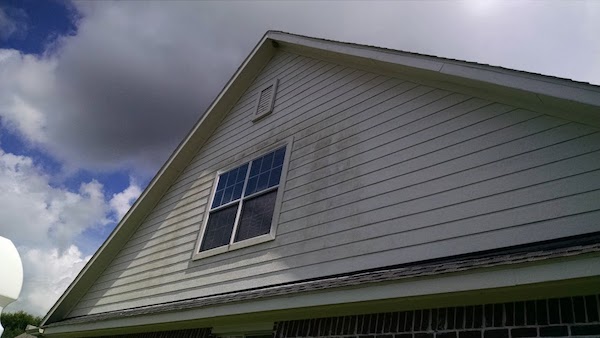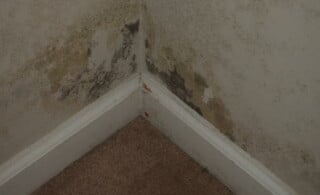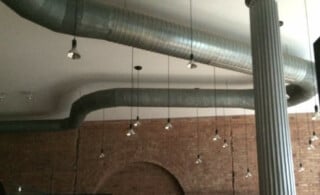
We see it on the shower curtain. We witness it growing in the basement. We notice it whenever we enter into a moist area of the house—that mildew-y smell. But what exactly is it and where does it come from? Well, mildew is a very specific form of mold that can grow anywhere in the home. It often flourishes in areas of excessive moisture and heat; add some humidity, some organic nutrients (dirt, oils, or other natural foods), and you have a mold garden on your hands. But not only is this growth unsightly, smelly, and damaging, it’s also a health risk: it wrecks havoc on asthma, allergies, and can be dangerous if ignored. Therefore it’s crucial that when you come across this fungi that you call a mildew remediation expert to get rid of it.
What, Where, and Why
When you notice black spots, light green stains, or even blue-white (almost milky) specks growing on surfaces of the home, you have a mildew problem. But where does it commonly grow? Great question: Everywhere. It can grow in the attic, basement, bathroom, or other levels of the home. It can grow on shower curtains, drapes, tile, siding, flooring, wood frames, concrete, insulation, and even on clothes (told you it got everywhere!). It can grow in any region of the country, in any climate, during any season. Even in the driest place on earth, condensation or sweating can still build and increase your chances for infestation—all it takes is the flip of the AC switch on a hot day and you’re at risk. It may take a long time to establish, but when it begins to grow, it gets everywhere fast. So when you see spores, you should immediately invest in some mildew removal in order to eradicate it before it gets worse.
Mildew Removal
Mildew remediation occurs on several levels. First, there are lots of home remedies out there which are very effective. But the biggest problem with quick fixes is the stuff you don’t see. Did you get it all? Are you still at risk? And what about the spores hiding behind the walls? This is why it’s best to call a professional mildew removal expert. They follow certain steps in order to completely stamp out this type of mold:
- Inspection: First they give the premises a thorough examination. They get in all the nooks and crannies, which is where this fungus loves to hide and build to dangerous proportions. It may help to lend a hand though; inform them of any possible explanations for the infestation: flooding, broken pipes, drafts, etc.
- Elimination: Next step, mildew removal. Once they find it all, they have the correct chemicals, technical know-how, and specialized procedures to fully eliminate the spores.
- Restoration: They can help make special repairs in order to prevent it from occurring again. If requested, they’ll repair drafts, install vapor barriers, or put in air exchangers. They may even be able to remove and/or replace wet or damaged materials as well.
Ready to start your mildew removal?
Find ProsPreventing Mildew Problems
Mildew remediation experts can also give you lots of specific advice about how to become more prepared in mildew prevention. Even if all the fungus is thoroughly eliminated, if the current living conditions aren’t altered as well, it’s guaranteed to happen again. So mildew prevention is crucial. Here are some tips to get you started:
- Downsize Dampness: The main cause is moisture. Therefore, it’s vital you guard against water buildup. Waterproof the concrete in your basement. Install vapor barriers in the walls. Thoroughly dry your clothes before storing them. Vent the air from your dryer out of the house. And replace any warped, damaged, or infested materials immediately.
- Get Ventilated: You don’t want hot, humid air to remain still and stagnant. In certain areas of the house, such as kitchens and bathroom, make sure to circulate the air with fans. Open the windows when you can. Turn up the AC and pull the furniture from the wall in order to ensure complete ventilation.
- Dry It Out: The air must be moving, but it must be dried as well. Purchase a dehumidifier or install kitchen and bathroom exhaust vents, or heat certain areas of the house with extra-strength light bulbs or space heaters to dry out the air (make sure you don’t heat up moist areas, which will then simply create more condensation).
- Chemicals: You can also invest in some chemical deterrents. They often come in granules that are designed to soak up moisture. Leave them in the container and hang it in your closet, or maybe take them out and sprinkle them around your dresser drawers.
- Keep It Clean: Not only do you want to avoid moisture, but you want to do away with any dirt, oils, soap scum, or any other filth that may collect in the home and provide nourishment to fungus.
 How to Remediate Mold
How to Remediate Mold  Your Home’s Circulatory System: Heating and Cooling Air Ducts
Your Home’s Circulatory System: Heating and Cooling Air Ducts  Lead Paint Common Sense
Lead Paint Common Sense  How Do I Get Rid of the Moldy Odor in My Basement?
How Do I Get Rid of the Moldy Odor in My Basement?  Air Duct Cleaning
Air Duct Cleaning 

Are You Familiar With This Topic? Share Your Experience.